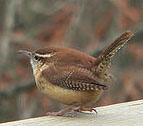 When cold temperatures and snow settle on our garden many new birds find their way to our feeders. The Carolina Wren is not a frequent visitor but when he comes we welcome him. His upright tail and round plump body make him easy to pick out even in a fluttering mass of feathered friends.
When cold temperatures and snow settle on our garden many new birds find their way to our feeders. The Carolina Wren is not a frequent visitor but when he comes we welcome him. His upright tail and round plump body make him easy to pick out even in a fluttering mass of feathered friends.
Size and Shape: 6-7” teacup shaped, rotund body; long, thin, curved bill; tail often held upright.
Color: brown back and head with rust breast and white neck; long white eye stripe.
Communication: “teakettle teakettle teakettle”; only males sing but do so loudly and frequently.
Range: Eastern US north to the Great Lakes and south into eastern Mexico.
Habitat: Year round resident in swampy, mixed hardwood forests, and yards with lots of shrubs and trees
Nesting: Males and females often mate for life; they build a bulky nest of bark strips, moss, grasses, leaves, fine twigs, and miscellaneous items in tree branches, holes, and stumps or a variety of man made structures such as flowerpots or mailboxes. The nest is domed shaped with a hole on the top. The female lays and incubates 4-6 eggs for 12- 14 days while being feed by the male. Both parents feed the chicks for 12-19 days until the chicks leave the nest. Carolina wrens typically have 2 broods, occasionally 3, and may reuse their nest.
Feeding: Insects, larvae, and spiders that live in leaf liter and bark make up most of their diet, but they also eat berries and fruit. When snow covers the ground they will come to feeders.
Backyard Tips: Carolina wrens like peanut butter suet mixtures and mealworms. They can not crack seeds but like the inside of sunflowers and will eat millet whole.
Comments: In warm weather Carolina wrens may enter houses in search of food but will find their way out, no worse for wear.
During warm winters the Carolina wrens extend their range northward but will suffer severe losses when cold winters return.
